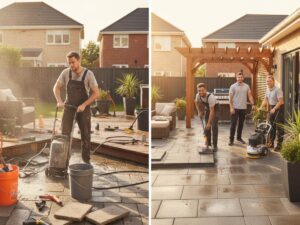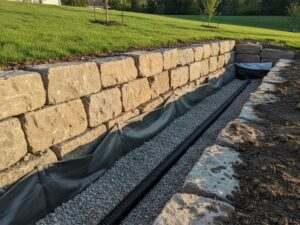Soil composition and type play a crucial role in how water moves through your yard. According to the USDA Natural Resources Conservation Service, soil is generally classified into four main types: sand, silt, clay, and loam, each defined by its particle size and water drainage capacity. In addition to these basic soil types and their yard drainage capacity, factors like soil structure, compaction, and organic matter also significantly affect how well (or poorly) water drains through your landscape.
If your yard has poor drainage, it can result in standing water, unhealthy plants, and even damage to your home’s foundation. That’s why understanding your soil type is the crucial first step toward creating effective drainage solutions and smart landscaping strategies. This guide will walk you through how different soil types impact drainage, along with some effective tips for improving soil drainage. Let’s take a look!
Soil Types and Their Impact on Yard Drainage
Let’s begin by understanding different soil types and their impact on yard drainage:
Clay Soil
Clay soil is composed of extremely fine particles that are tightly packed, which leaves very little room for air pockets or water movement, leading to yard water drainage problems. This also results in very slow drainage, often leading to surface puddling or waterlogged roots, especially after rainfall. Because of its density, clay tends to compact easily under foot traffic or machinery, further reducing drainage efficiency. Poor aeration in clay soil can suffocate plant roots, increase susceptibility to fungal diseases, and stunt plant growth. Additionally, during dry spells, clay soils crack and become rock-hard, making them difficult to work with.
Sandy Soil
This soil consists of large, coarse particles with wide gaps between them, allowing water to pass through quickly and easily. This characteristic makes sandy soil ideal for rapid drainage, which can help prevent surface flooding or root rot. However, the downside is that it doesn’t retain water or nutrients well, meaning frequent watering and fertilization are required to support plant health. This type of soil can be particularly challenging in hot, dry climates where moisture evaporates rapidly.
Silty Soil
Silty soil is made up of fine mineral particles that are smaller than sand but larger than clay, giving it a smooth, almost slippery texture when wet. Its structure allows for moderate drainage, making it more effective than clay at moving water, but still capable of retaining adequate moisture for plant use. Silty soil is often fertile due to its ability to hold onto nutrients, but it can become compacted easily, especially when wet, which reduces infiltration over time. Crusting on the surface is also common, which can hinder seedling emergence and water absorption.
Loamy Soil
By now, you must have conferred the importance of soil types. Well, the perfect one is here! Loamy soil is the most balanced and desirable soil type for yard and garden drainage. It is a mixture of sand, silt, and clay, combining the best properties of each: excellent drainage, moisture retention, and nutrient availability. Its crumbly, soft texture allows water to infiltrate easily while holding enough moisture to sustain plants during dry periods. Loam resists both erosion and compaction better than pure sand or clay, and it creates an environment where plant roots can access water, air, and nutrients efficiently. As a result, loam is often referred to as the “gardener’s dream” and requires minimal amendment.
Proven Methods to Identify Soil Type for Better Drainage
Feel the Texture with a Quick Hand Test
A quick and surprisingly accurate way to identify soil type is by touch. Take a moist handful of soil and rub it between your fingers.
- If it feels gritty and falls apart easily, it’s sandy.
- If it’s smooth and silky, you’ve likely got silt.
- If it’s sticky, forms a tight ball, and doesn’t crumble, that’s clay.
- Loam will feel crumbly and soft but slightly gritty.
Texture matters because it directly impacts drainage: gritty soils drain fast, while sticky soils hold water. This tactile method gives you instant feedback and can be used alongside other tests for confirmation.
Do a Simple Drainage Percolation Test
Knowing how fast your soil drains is essential. Dig a hole about 12 inches deep and wide, fill it with water, and watch how quickly it drains.
- If the water disappears in under 30 minutes, your soil is very sandy and drains too fast.
- If it takes more than 4 hours, it’s likely clay-heavy and poorly draining.
- If water drains in about 1 to 2 hours, you may have loamy soil.
- If the drainage is uneven and slow but not quite as stubborn as clay, your soil might be silty, especially if it feels soft and smooth when wet
Ideal drainage is when water drains within 1 to 2 hours. This easy test helps you understand whether you need to slow down or speed up water flow in your yard.
Use a Soil Testing Kit for pH and Nutrient Insight
While soil types and yard drainage capacity tell part of the story, a soil test kit or lab analysis gives you a deeper look. These tests measure your soil’s pH level (acidic, neutral, or alkaline) and can identify nutrient deficiencies like nitrogen, phosphorus, or potassium. Knowing your pH and nutrient profile can help you choose the right plants, soil amendments, or fertilizers. Most garden centers sell inexpensive home kits, or you can send a sample to your local cooperative extension service for detailed analysis.
Tailored Yard Drainage Solutions Based on Soil Type
Here are some expert drainage solutions for different soil types:
Use the Right Drainage Fix for Clay or Compacted Soils
If you’ve identified clay-heavy or compacted soil, the key is improving soil structure and enhancing surface drainage. Start by mixing in organic matter like compost, leaf mold, or gypsum to loosen the dense clay. In stubborn areas, installing French drains or dry creek beds can help redirect excess water away from problem zones. For persistent water pooling, consider grading your yard to create a slight slope that encourages runoff. The goal is to open up the soil and move water efficiently without flooding other areas.
Boost Sandy Soil with Organic Amendments and Smart Irrigation
Post the test, if it reveals sandy soil, the solution is all about slowing water down and improving retention. Incorporate generous amounts of organic compost, biochar, or peat moss to give sand more structure and water-holding capacity. For gardens, installing a drip irrigation system instead of overhead sprinklers ensures that water gets directly to the roots with minimal loss. You may also consider using mulch layers to reduce evaporation and keep moisture in the soil longer.
Treat Silty Soil with Aeration and Organic Support
In case your soil feels soapy and smooth, you’re likely dealing with silt. Improve drainage by aerating the soil regularly, especially in lawn areas, and incorporating coarse compost to create better structure. Avoid tilling when the soil is wet, as that can worsen compaction. Installing a rain garden or bioswale can also help manage water more effectively in silt-heavy yards, especially on slight slopes.
Love Your Loam? Maintain It with Organic Matter
If you have loam soil, consider yourself lucky! Loam drains well, holds nutrients, and supports plant life better than any other soil type. But even loam can degrade over time due to erosion, compaction, or organic matter loss. Maintain your perfect soil balance by adding compost regularly, mulching, and avoiding compaction (don’t walk on wet soil).
By knowing your soil type, you can tackle drainage issues before they become costly problems. Whether you’re battling puddles or parched plants, the right solution starts with expert insight. Trust My Landscape Contractor, your local yard drainage contractor, to design smarter, drier, healthier outdoor spaces.




